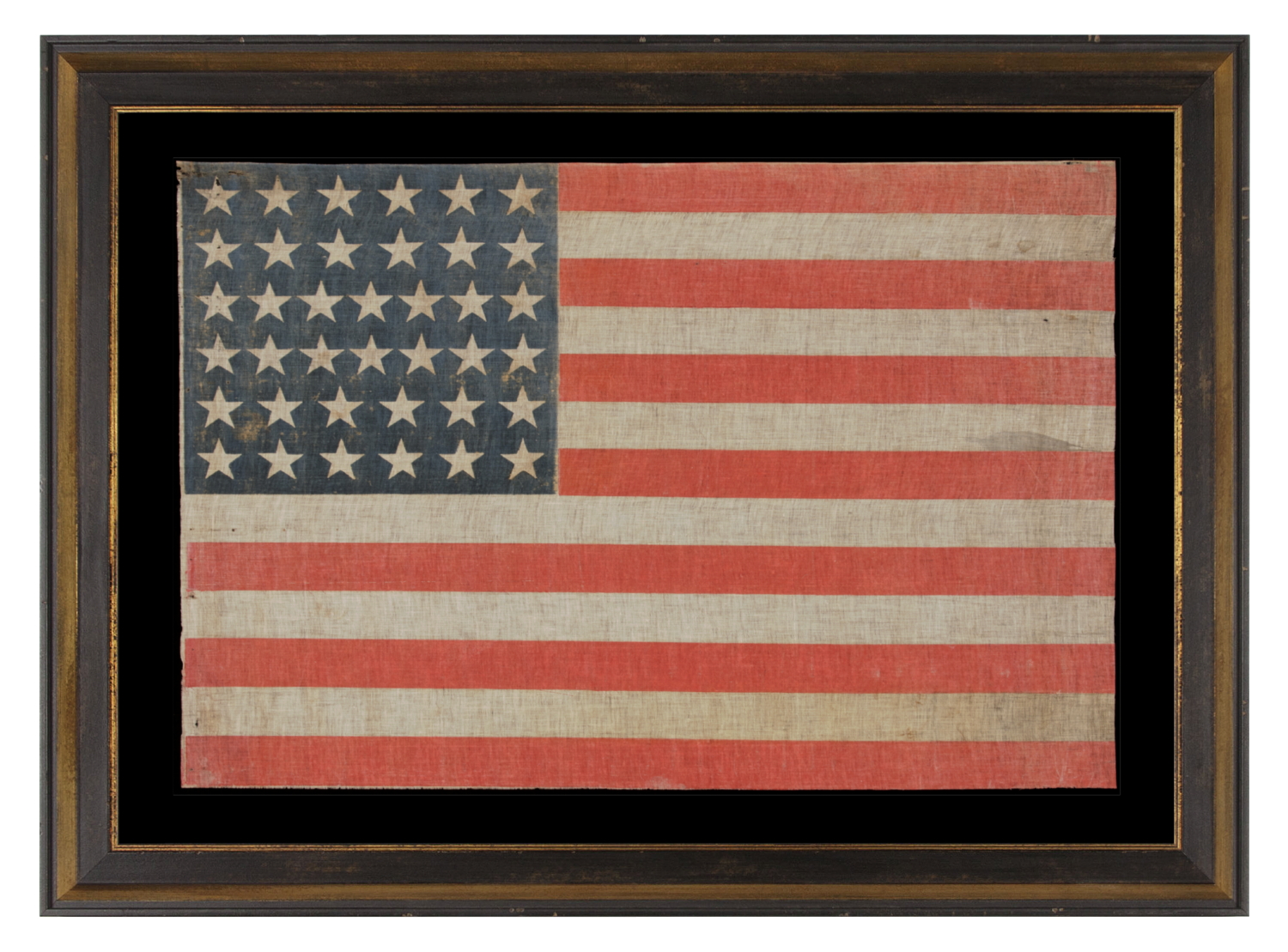
| |
38 STARS ON A PARADE FLAG WITH ESPECIALLY LARGE SCALE AND BEAUTIFUL, PERSIMMON RED STRIPES, COLORADO STATEHOOD, 1876-1889 |
|
| Available: |
Sold |
| Frame Size (H x L): |
Approx. 40.5" x 54.5" |
| Flag Size (H x L): |
28.5" x 42.5" |
|
| Description....: |
|
38 star American national parade flag, printed on coarse, glazed cotton. The stars are arranged in justified rows of 6-6-7-7-6-6. The fact that the stars are quite large with respect to the amount of space they fill contributes to the presentation, as does the brilliant color of the persimmon red stripes.
Colorado became the 38th state on August 1st, 1876. This was the year of our nation’s 100-year anniversary of independence. Per the Third Flag Act of 1818, stars were not officially added until the 4th of July following a state's addition. For this reason, 37 was the official star count for the American flag in 1876. Flag-making was a competitive venture, however, and few flag-makers would have been continuing to produce 37 star flags when their competitors were making 38’s. It is for this reason that 38 and 13 stars (to represent the original 13 colonies) are more often seen at the Centennial International Exposition, the six-month long World’s Fair held in Philadelphia in honor of the event. Some flag-makers would have been adding a star for the 38th state even before it entered the Union, in the early part of 1876 or even prior. In fact, many makers of parade flags were actually producing 39 star flags, in hopeful anticipation of the addition of two more Western Territories instead of one. But the 39th state would not join the Union for another 13 years, when the Dakota Territory entered as two states on the same day. The 38 star flag became official on July 4th, 1877 and was generally used until the addition of the Dakotas in 1889.
President Ulysses S. Grant was in office when the first 38 star flags would have appeared. The list of presidents serving during the period when the 38 star flag was actually official include Rutherford B. Hayes, James Garfield, Chester Arthur, Grover Cleveland, and Benjamin Harrison.
Most parade flags measure 3 feet or less on the fly. At 42.5 inches this is an unusually large example with excellent graphic impact. Because most flags with pieced-and-sewn construction (as opposed to printed) are significantly larger and more difficult to frame and display, the bold but manageable size of this flag is a very desirable trait.
Mounting: The flag has been hand-stitched to 100% cotton, black in color, that has been washed to reduce excess dye. An acid-free agent was added to the wash to further set the dye and the fabric was heat-treated for the same purpose. The mount was then placed in a substantial, black-painted, Italian molding of excellent quality, to which a black-painted, silver gilded and distressed liner was added. The glazing is U.V. protective Plexiglas.
Condition: There are a number of tiny holes along and near the hoist end, accompanied by a tiny area of loss along the top edge near the fly end and a tiny hole near the fly end of the 2nd white stripe. There is moderate pigment loss and oxidation in the canton and there is minor soiling and oxidation throughout, which is slightly more significant along the last 3 stripes and along the fly end. Many of my clients prefer early flags to show their age and history of use. |
|
|
|
| Collector Level: |
Intermediate-Level Collectors and Special Gifts |
|
| Flag Type: |
Parade flag |
|
| Star Count: |
38 |
|
| Earliest Date of Origin: |
1876 |
|
| Latest Date of Origin: |
1889 |
|
| State/Affiliation: |
Colorado |
|
| War Association: |
1866-1890 Indian Wars |
|
| Price: |
SOLD |
|
| |
Views: 3160 |
|
|
|

